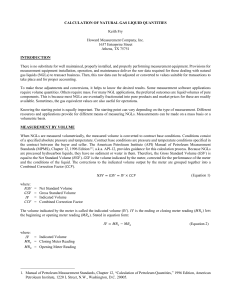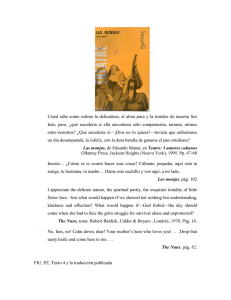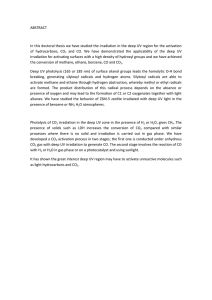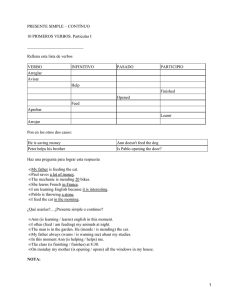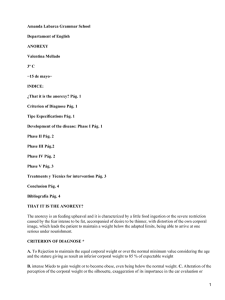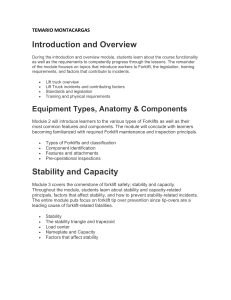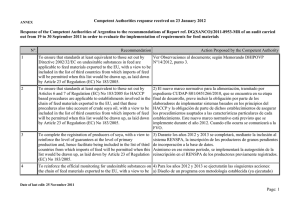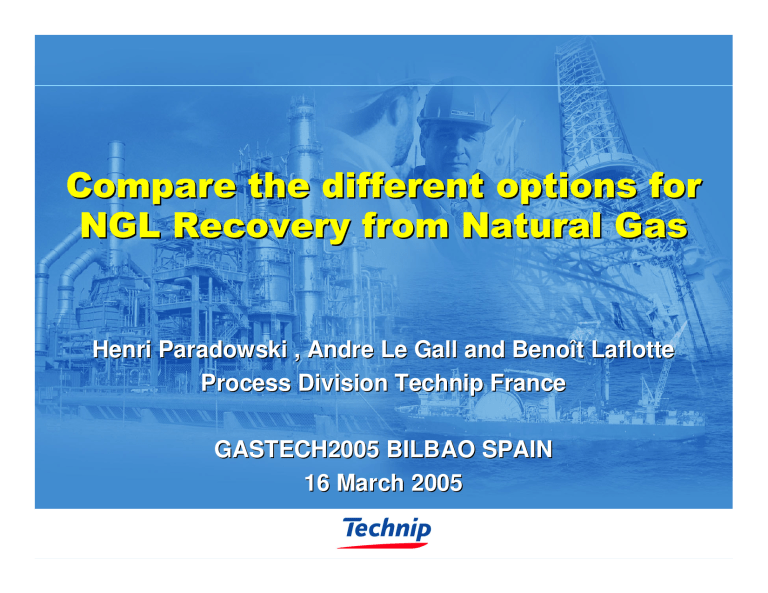
Compare the different options for NGL Recovery from Natural Gas Henri Paradowski , Andre Le Gall and Beno ît Laflotte Benoît Process Division Technip France GASTECH2005 BILBAO SPAIN 16 March 2005 Contents 1 Market 2 Gas and NGL chains from wellhead to the consumer 3 Dehydration: Mol sieves or TEG? 4 Ethane recovery : which process ? 5 NGL fractionation: how to save energy? 6 NGL refrigeration: which cycle use? 1 1. Market driven ? Gas / NGL's market prices translate into an extraction margin in the US Similar situation in North Sea Henry Hub / Mount Belvieu monthly spot averages Natural Gas, Propane, n-Butane 10 8 7 6 5 4 3 2 juin-04 sept-04 déc-04 nov-03 mars-04 mai-03 août-03 déc-01 avr-02 juil-02 oct-02 janv-03 juin-01 sept-01 mars-99 juil-99 oct-99 janv-00 mai-00 août-00 nov-00 févr-01 nov-97 févr-98 juin-98 sept-98 déc-98 avr-97 août-97 oct-96 janv-97 1 déc-95 mars-96 juil-96 C2 recovery only worth if a petrochemical market is at hand 9 US $ / MMBtu C3 / C4's recovery justified in most instances Sources: EIA / Barnes and Click 2 2. Gas and NGL chains : from wellhead to the consumer Plant complexity function of Gas characteristics and targeted products Plant geographical location Example : Western Libya Gas Project* Treated Gas / Treated Crude / Propane / Butane Onshore • Wafa Desert Plant : Gas Sweetening, Liquids extraction (blended with stabilized Crude) • Oil and Gas Pipeline to coast (over 500 km) • Liquids fractionation at Wafa Coastal Plant Offshore • Gas and Condensate sent to shore (Mellitah) for treatment and fractionation. * Source : ENI web site (Investor Relations), October 2004 3 3. Pre-treatment options : focus on dehydration 3.1 Hydrates formation temperature Water content ppm mole 20 10 5 2 1 .5 .2 .1 Natural gas at 62 bar -20 -27 -33 -42 -49 -55 -64 -70 Natural gas at 30 bar -26 -32 -39 -47 -53 -59 -66 -72 4 3. Pre-treatment options : focus on dehydration 3.2 Mole Sieves : a standard option for deep NGL recovery Achieve 0.1 ppm water content Capital intensive and energy intensive May be troublesome in operation Design with care • Upstream separation of utmost importance, • Regeneration sequence to be carefully studied, • Mole sieve binder to be carefully selected. 5 3. Pre-treatment options : focus on dehydration 3.3 TEG dehydration: a valid option in most cases Achieve 1 to 10 ppm water content in dry gas Minimizes CAPEX and OPEX Less maintenance and operational issues Design Issues • • • • Sensitive to Absorber feed gas temperature Design Absorber with vendor of internals:packing,distributors,.. Design outlet separators to avoid TEG carry over Pure TEG melting point is –5 °C 6 3. Pre-treatment options : focus on dehydration 3.4 TEG dehydration sensitivity: dehydration at 62 bars Natural gas Temperature °C Number of stages TEG water content % weight Dry gas water content ppm mole 34 4 0.1 6.3 24 3 0.1 4.0 24 4 0.1 2.9 24 4 0.2 5.5 7 4. Ethane recovery : which process choose 4.1 Propane market accepts additional low sulfur LPG No world wide Ethane market Ethane production : constant or Variable? Feed Gas and Sales gas constant or variable ? 8 4. NGL Recovery process : Constant Ethane 4.2 Constant Ethane with variable Feed Gas Situation met in Europe : Lacq from 1987 to 2000 • High sales production during winter and reduced gas production in summer,constant ethane production to meet the ethylene production Option 1 : reject Option 2 : modify recovery rate Dual Reflux Process is an attractive solution : 9 Single Reflux Ethane Recovery Ethane recovery 72.4% : 47900 kg/h Power 180 kW.h / t NGL 738 mmscfd 23600 kW 7600 kW Sales gas K1 T1 738 mmscfd GT K2 E2 60 bar 34°C 25 bars -94°C C1 E1 Feed gas 60 bar 800 mmscfd V1 -34°C 129700 kg/h NGL (C2+) 10 Dual Reflux Ethane Recovery Ethane recovery : 84.8% 49100 kg/h Power 195 kW.h / t NGL 84 mmscfd 725 mmscfd 23600 kW 7100 kW recycle K1 T1 641 mmscfd Sales gas GT K2 E2 60 bar 25 bars -99°C C1 E1 Feed gas 60 bar 700 mmscfd V1 -34°C 121200 kg/h NGL (C2+) 11 Dual Reflux Ethane Recovery Ethane recovery : 96 % 47650 kg/h Power 215 kW.h / t NGL 6800 kW 168 mmscfd 714 mmscfd 23400 kW recycle K1 T1 546 mmscfd Sales gas GT K2 E2 60 bar 25 bars -102°C C1 E1 Feed gas 60 bar 600 mmscfd V1 -34°C 109500 kg/h NGL (C2+) 12 Multiple Reflux Ethane Recovery Ethane recovery 88.6 % 51300 kg/h Power 191 kW.h / t NGL 84 mmscfd 724 mmscfd 23600 kW 7100 kW recycle K1 T1 640 mmscfd Sales gas GT K2 E2 60 bar 25 bars -100°C C1 E1 Feed gas 60 bar 700 mmscfd V1 -34°C V2 123400 kg/h NGL (C2+) 13 4. Ethane recovery : Variable Ethane production 4.3 Variable Ethane ( with constant Feed Gas ) Option 1 : recover C2 and reject C2 to sales gas • Effective easy to operate but costly in fuel Option 2 : limit recovery and possibly loose some C3 • Easy to operate but not economic if C3 price is high Option 3 : switch from a high C2 recovery scheme to a low C2 and high C3 recovery scheme • Efficient but needs skilled operators Option 4 : change operating conditions : slowly go from a high C2 recovery to low C2 and high C3 recovery • Efficient and easy to operate but higher CAPEX 14 4. The ethane recovery dilemma 4.4 Conclusion To choose the best scheme The different options have to be compared Some options shall be left open in design competition for LSTK Client has to evaluate different production scenarios It is always possible to modify a Propane recovery scheme to obtain an Ethane recovery scheme Some provisions have to be taken 15 5. NGL Fractionation : an energy sink 5.1 Observation High energy demand for NGL fractionation Example in Jose, Venezuela Deethaniser Duty Reboiler Product (kW) (t/h) 21700 65 Ethane Depropaniser 17800 80 Propane Debutanizer 11500 45 C5+ C4 Splitter 20000 55 i+n C4 TOTAL 71000 245 Reboiling Heat 300 kW.h / t of NGL Fuel 360 kW.h / t of NGL 5.2 Solutions to minimize this energy consumption Study heat integration Combine fractionation with cogeneration 16 5. NGL Fractionation : an energy sink 5.3 NGL Fractionation with Heat Integration C3 Ethane 65 t/h Propane 80 t/h i-Butane 20 t/h integration NGL Feed 245 t/h Hot oil Hot oil Hot oil Hot oil C5+ 45 t/h Deethaniser Depropaniser Debutaniser n-Butane 35 t/h C4 splitter 17 5. NGL Fractionation : an energy sink 5.4 NGL Fractionation with Cogeneration C3 Ethane 65 t/h Propane 80 t/h LP Steam LP Steam i-Butane 20 t/h NGL Feed 245 t/h LP Steam LP Steam C5+ 45 t/h Deethaniser Depropaniser Debutaniser n-Butane 35 t/h C4 splitter 18 5. NGL Fractionation : an energy sink 5.5 Cogeneration 110 t/h 63 bar abs Boiler(s) 440°C G 14 MW 150°C Preheaters 5 bar abs Reboilers 19 5. NGL Fractionation : an energy sink 5.6 Comparison Highest column bottom temperature (°C) Heating Medium for reboilers Fuel consumption kW Electrical Power Production kW Efficiency Possible use of GT exhaust gases CAPEX No integration Process integration Cogeneration 125°C 170°C 125°C Hot Water Hot Oil LP Steam 88 000 88 000 88 000 N/A N/A 14 000 high yes low yes medium high 20 6. C3 Refrigeration and Atmospheric Storage: which cycle? 6.1 : 3 options considered C3 Boil Off Gas compressor , closed propane loop and C3 compressor with 1st stage suction under vacuum, C3 Boil Off Gas compressor , closed propane loop and C3 compressor with 1st stage suction above atmospheric pressure, Semi open propane loop , single propane compressor with suction at atmospheric pressure , for Boil Off Gas and C3 refrigerant . 21 6. C3 Refrigeration and Atmospheric Storage: which cycle? 6.2 Closed Loop Propane Overall Power Consumption: 5700 kW Propane BOG 8.5 bar 2.4 bar Propane Rundown 160 t/h 1.3 t/h 0.7 bar 22 6. C3 Refrigeration and Atmospheric Storage: which cycle? 6.3 Semi-Open Loop Propane Overall Power Consumption: 5400 kW Propane BOG 8.9 bar 2.7 bar 10 t/h 1.0 bar Propane Rundown 160 t/h 23 6. C3 Refrigeration and Atmospheric Storage: which cycle? 6.4 Comparison LP C3 Suction Pressure CLOSED LOOP CLOSED LOOP SEMI-OPEN Vacuum Atmospheric Atmospheric 0.7 bar a 1.2 bar a 1.0 bar a CAPEX Safety lower good 24 7. Conclusion To design , build and operate the best NGL plant Many options are available and have to be compared Success factors Understand the requirements Operability comes first Collaboration between Client-Contractor-Suppliers 25
